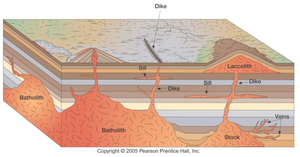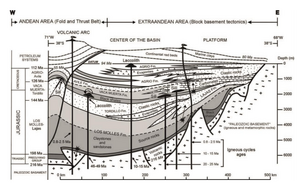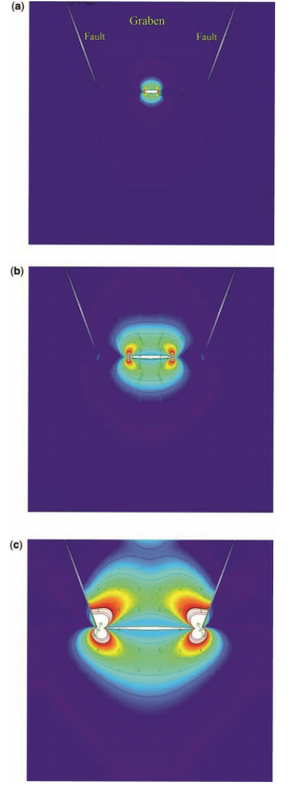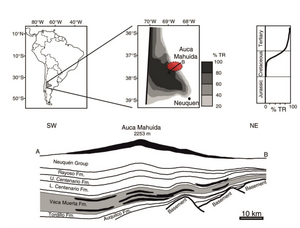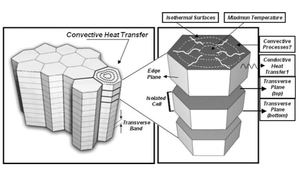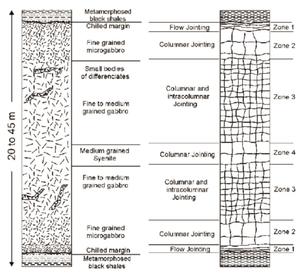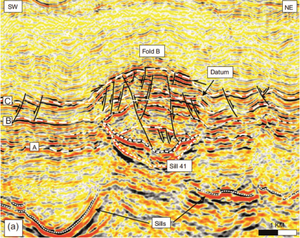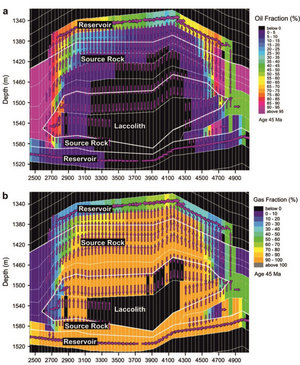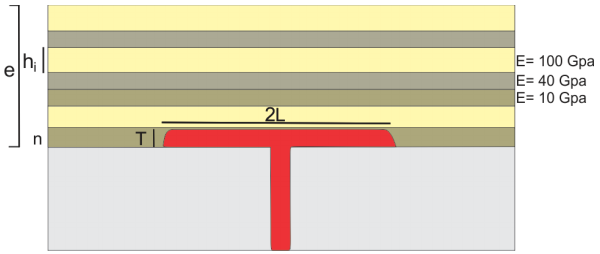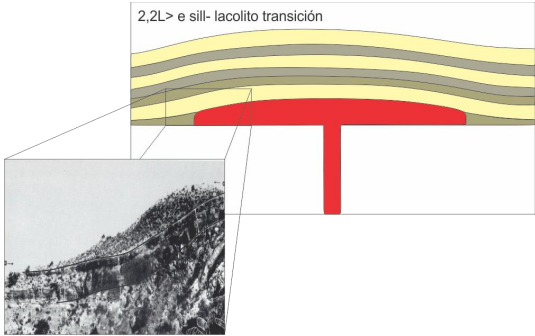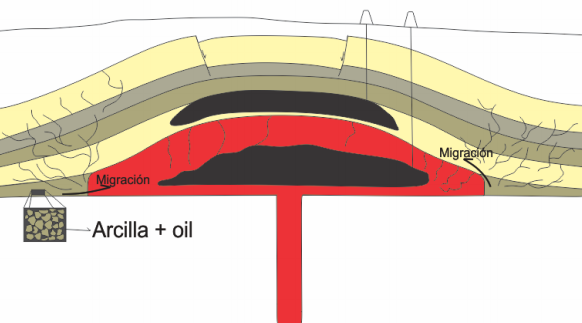Difference between revisions of "Hydrocarbon reservoirs associated to layered intrusive bodies"
| Line 3: | Line 3: | ||
INTRODUCCION | INTRODUCCION | ||
| − | Magma is defined as a molten rock, which behaves as a viscous liquid generated multiple tectonic processes. The ascent to the fragile crust generates bodies of varying geometry. [[File:IMAGEN 1.png|thumbnail|Fig . 1. Types of magmatic bodies.]] | + | Magma is defined as a molten rock, which behaves as a viscous liquid generated multiple tectonic processes. The ascent to the fragile crust generates bodies of varying geometry (Fig 1). [[File:IMAGEN 1.png|thumbnail|Fig . 1. Types of magmatic bodies.]] |
The morphology presented deployed such bodies depends on the viscosity, the amount of | The morphology presented deployed such bodies depends on the viscosity, the amount of | ||
magma available, the list of regional efforts and magmas own composition. They can be | magma available, the list of regional efforts and magmas own composition. They can be | ||
| Line 18: | Line 18: | ||
The focus of the article is aimed at magmatic bodies of small size (2-4 km in diameter and | The focus of the article is aimed at magmatic bodies of small size (2-4 km in diameter and | ||
approximately 500 m thick) of laminar geometries and disposal consistent with available | approximately 500 m thick) of laminar geometries and disposal consistent with available | ||
| − | subhorizontal sedimentary rocks. | + | subhorizontal sedimentary rocks(Fig 2). |
[[File:IMAGEN 2.png|thumbnail|Figure 2 : Schematic profile of the Neuquen Basin, province of Neuquen, Argentina , where you can see the site of lamellar bodies of Cenozoic age. Taken from Bermúdez & Delpino 2015.]] | [[File:IMAGEN 2.png|thumbnail|Figure 2 : Schematic profile of the Neuquen Basin, province of Neuquen, Argentina , where you can see the site of lamellar bodies of Cenozoic age. Taken from Bermúdez & Delpino 2015.]] | ||
| Line 33: | Line 33: | ||
overcome the resistance of the rocks magma vertically looking for a new way of | overcome the resistance of the rocks magma vertically looking for a new way of | ||
moving through a plane of weakness such as a stratigraphic unconformity, | moving through a plane of weakness such as a stratigraphic unconformity, | ||
| − | anisotropy of the medium as fault planes, hinges of folds, etc. | + | anisotropy of the medium as fault planes, hinges of folds, etc (Fig 3 and Fig 4). |
[[File:IMAGEN 3.png|thumbnail|Figure 3: In this photograph the site of two sills can be seen in a bedrock (Vaca Muerta Fm). Right on the sector focuses it can be clearly seen intense fracturing of columnar pattern. Photo courtesy of Juan Spacapan.]] | [[File:IMAGEN 3.png|thumbnail|Figure 3: In this photograph the site of two sills can be seen in a bedrock (Vaca Muerta Fm). Right on the sector focuses it can be clearly seen intense fracturing of columnar pattern. Photo courtesy of Juan Spacapan.]] | ||
| + | [[File:IMAGEN 4.png|thumbnail|Figure 4: mathematical modeling where the stress distribution can be observed during the site of a sill.Taken from Gudmundsson & Løtveit 2012.]] | ||
Another important physical factor is the pore pressure. In porous sedimentary | Another important physical factor is the pore pressure. In porous sedimentary | ||
| Line 40: | Line 41: | ||
reduced. This is why it can almost be deduced that the location of the intrusive | reduced. This is why it can almost be deduced that the location of the intrusive | ||
within a sedimentary basin would be concentrated within shale formations (high | within a sedimentary basin would be concentrated within shale formations (high | ||
| − | porosity) with plenty of oil. | + | porosity) with plenty of oil (Fig 5 and Fig 6). |
| − | + | ||
[[File:IMAGEN 5.png|thumbnail|Figure 5: Diagram relating the fluid pressure with the decrease in resistance of the country rock with increasing depth . Notice how the anisotropy of the medium magnify the value of T ( tensile stress) in the horizontal direction. Taken from Gressier et al 2010.]] | [[File:IMAGEN 5.png|thumbnail|Figure 5: Diagram relating the fluid pressure with the decrease in resistance of the country rock with increasing depth . Notice how the anisotropy of the medium magnify the value of T ( tensile stress) in the horizontal direction. Taken from Gressier et al 2010.]] | ||
[[File:IMAGEN 6.png|thumbnail|Figure 6: experiment by Gressier et al 2010 made into a powder through diatomaceous saturated and unsaturated to simulate fluid through the sediment site. Magma was simulated with silicone caulk which behaves as an ideal Newtonian fluid. The conclusion of this experiment is that in a supersaturated fluid medium and the main effort horizontally oriented sill development is full.]] | [[File:IMAGEN 6.png|thumbnail|Figure 6: experiment by Gressier et al 2010 made into a powder through diatomaceous saturated and unsaturated to simulate fluid through the sediment site. Magma was simulated with silicone caulk which behaves as an ideal Newtonian fluid. The conclusion of this experiment is that in a supersaturated fluid medium and the main effort horizontally oriented sill development is full.]] | ||
| Line 52: | Line 53: | ||
presumably has to do with three factors: pore pressure, level weakness is the bedrock | presumably has to do with three factors: pore pressure, level weakness is the bedrock | ||
(being shale is less competent ) and plans anisotropy generated in the shales facilitate | (being shale is less competent ) and plans anisotropy generated in the shales facilitate | ||
| − | deflection of the levees that are rising from lower levels. | + | deflection of the levees that are rising from lower levels (Fig 7). |
[[File:IMAGEN 7.png|thumbnail|Figure 7: Scheme of northern Neuquen basin where it can be seen as most sills are deployed in the Vaca Muerta Formation (hydrocarbon source rock).]] | [[File:IMAGEN 7.png|thumbnail|Figure 7: Scheme of northern Neuquen basin where it can be seen as most sills are deployed in the Vaca Muerta Formation (hydrocarbon source rock).]] | ||
Fracturing: as shown above for the location of magma is necessary to move adjacent | Fracturing: as shown above for the location of magma is necessary to move adjacent | ||
| Line 69: | Line 70: | ||
Columnar or polygonal fractures: are generated by cooling and solidification of | Columnar or polygonal fractures: are generated by cooling and solidification of | ||
magma, where its volume is reduced contraction columnar cells formed orthogonal | magma, where its volume is reduced contraction columnar cells formed orthogonal | ||
| − | to the surface through which heat is lost. | + | to the surface through which heat is lost (Fig 8 and Fig 9). |
[[File:IMAGEN 8.png|thumbnail|Figure 8: Scheme of columnar fractures. Taken from Bermúdez & Delpino 2015.]] | [[File:IMAGEN 8.png|thumbnail|Figure 8: Scheme of columnar fractures. Taken from Bermúdez & Delpino 2015.]] | ||
[[File:IMAGEN 9.png|thumbnail|Figure 9: Variation of fracture patterns in a vertical section of a sill. Taken from Bermúdez & Delpino 2015.]] | [[File:IMAGEN 9.png|thumbnail|Figure 9: Variation of fracture patterns in a vertical section of a sill. Taken from Bermúdez & Delpino 2015.]] | ||
| Line 75: | Line 76: | ||
• Folding: the movement of material not only produces fracturing but also the folding of | • Folding: the movement of material not only produces fracturing but also the folding of | ||
the overlying material. These folds are important because they may constitute important | the overlying material. These folds are important because they may constitute important | ||
| − | reservoirs and traps, even exploited in several basins in the world. | + | reservoirs and traps, even exploited in several basins in the world (Fig 10). |
[[File:IMAGEN 10.png|thumbnail|Figure 10: 2D seismic conducted northeast of Rockall basin, North Sea Norway. Observe normal faults as a product to accommodate the deformation of the fold. Taken from Hansen & Cartwright 2006.]] | [[File:IMAGEN 10.png|thumbnail|Figure 10: 2D seismic conducted northeast of Rockall basin, North Sea Norway. Observe normal faults as a product to accommodate the deformation of the fold. Taken from Hansen & Cartwright 2006.]] | ||
• Thermal Maturity: the intrusion of magma of high temperatures (up to 1200 ° C) has a | • Thermal Maturity: the intrusion of magma of high temperatures (up to 1200 ° C) has a | ||
thermal effect on the country rock can get to promote maturation of hydrocarbons when | thermal effect on the country rock can get to promote maturation of hydrocarbons when | ||
| − | diagenetic conditions are not optima. | + | diagenetic conditions are not optima (Fig 11). |
[[File:IMAGEN 11.png|thumbnail|Figure 11: modeling of the distribution and direction of migration of oil and gas after the intrusion and cooling of a lacolito in the north of the Neuquen Basin and into the Vaca Muerta Fm province of Neuquen, Argentina ]] | [[File:IMAGEN 11.png|thumbnail|Figure 11: modeling of the distribution and direction of migration of oil and gas after the intrusion and cooling of a lacolito in the north of the Neuquen Basin and into the Vaca Muerta Fm province of Neuquen, Argentina ]] | ||
| Line 88: | Line 89: | ||
to intense secondary patency generated both in the country rock and the same intrusive | to intense secondary patency generated both in the country rock and the same intrusive | ||
given by fracturing the formation of stratigraphic traps as fold forced and effects thermal | given by fracturing the formation of stratigraphic traps as fold forced and effects thermal | ||
| − | maturity they produce hydrocarbons by high temperature. | + | maturity they produce hydrocarbons by high temperature (Fig 12,13 and 14). |
[[File:IMAGEN 12.png|framed|left|Figure 12: first stage in the construction of a sill. The levels correspond to greenish mudstones ( E in very low resistance GPa) .]] | [[File:IMAGEN 12.png|framed|left|Figure 12: first stage in the construction of a sill. The levels correspond to greenish mudstones ( E in very low resistance GPa) .]] | ||
Revision as of 18:25, 26 June 2015
HYDROCARBON RESERVOIRS ASSOCIATED TO LAYERED INTRUSIVE BODIES
INTRODUCCION
Magma is defined as a molten rock, which behaves as a viscous liquid generated multiple tectonic processes. The ascent to the fragile crust generates bodies of varying geometry (Fig 1).
The morphology presented deployed such bodies depends on the viscosity, the amount of magma available, the list of regional efforts and magmas own composition. They can be classified in globular and lamellar bodies exist as transitional laccoliths. The location of these in sedimentary basins has considerable economic importance globally because it generates fruitful hydrocarbon reservoirs. Examples of these are: Neuquen basin in Argentina, Rockall Basin in the Norwegian Sea and the Yellow Sea Basin in China.
FACTORS CONTROLLING THE EMPLACEMENT OF MAGMA
The magmatic emplacement in the crust is not a freak of nature, it is controlled by a number of physical factors. It will highlight the constraints posed by the location of sedimentary basins subvolcanic due to the importance of these as part of hydrocarbon systems. The focus of the article is aimed at magmatic bodies of small size (2-4 km in diameter and approximately 500 m thick) of laminar geometries and disposal consistent with available subhorizontal sedimentary rocks(Fig 2).
Location factors are: Tectonic: the dynamics of plates associated sedimentary basin must have significant magmatic activity, with interspersed relaxation events in time and needed to climb it. Physical: the density difference between the magma (lower density) and the host rocks is a key factor. Archimedes' principle is the one who acts. The surrounding rocks exert an upward thrust that moves the crustal magma to levels where their density is equated with the host rocks. It may happen that the density remains below the rocks of the environment and that the magma is detained its vertical ascent, the factor involved here are local efforts. If the efforts of the magma pressure can not overcome the resistance of the rocks magma vertically looking for a new way of moving through a plane of weakness such as a stratigraphic unconformity, anisotropy of the medium as fault planes, hinges of folds, etc (Fig 3 and Fig 4).
Another important physical factor is the pore pressure. In porous sedimentary rocks saturated with fluids such as water and hydrocarbons, fracture resistance is reduced. This is why it can almost be deduced that the location of the intrusive within a sedimentary basin would be concentrated within shale formations (high porosity) with plenty of oil (Fig 5 and Fig 6).
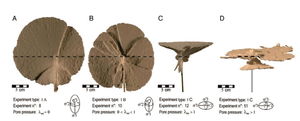
CONSEQUENCES OF CONSTRUCTION SILLS The location of magmatic sill type bodies within sedimentary lithologies has four major consequences: Location in bedrock: has been observed in numerous world sites, site of intrusive occurs in petroleum source rocks, whose cause is still not fully understood but presumably has to do with three factors: pore pressure, level weakness is the bedrock (being shale is less competent ) and plans anisotropy generated in the shales facilitate deflection of the levees that are rising from lower levels (Fig 7).
Fracturing: as shown above for the location of magma is necessary to move adjacent sedimentary rock. The magma pressure is what generates the efforts for this to have committed and also achieved fracturing . Other efforts such as those generated by cooling the sill or by the circulation of metasomatic fluids are also responsible for much of the rock fracturing cash as the sill itself. We have studied the fracture patterns formed by these processes are explained below some. Radial fractures: fracture pattern generated in the sediments by the efforts of the magma pressure, radiating from a central point. Fractures located at the corners of the sill: as seen in Figure 4 the stress concentration at the ends of the sill is very rich and very intense fracturing in consequence. Concentric fractures: generated at the edges of the sill and parts of the country rock by the circulation of metasomatic fluids or lithostatic decompression. Columnar or polygonal fractures: are generated by cooling and solidification of magma, where its volume is reduced contraction columnar cells formed orthogonal to the surface through which heat is lost (Fig 8 and Fig 9).
• Folding: the movement of material not only produces fracturing but also the folding of the overlying material. These folds are important because they may constitute important reservoirs and traps, even exploited in several basins in the world (Fig 10).
• Thermal Maturity: the intrusion of magma of high temperatures (up to 1200 ° C) has a thermal effect on the country rock can get to promote maturation of hydrocarbons when diagenetic conditions are not optima (Fig 11).
CONCLUSIONS:
The sill type intrusives are important reservoirs of hydrocarbons in sedimentary basins due
to intense secondary patency generated both in the country rock and the same intrusive
given by fracturing the formation of stratigraphic traps as fold forced and effects thermal
maturity they produce hydrocarbons by high temperature (Fig 12,13 and 14).
ACKNOWLEDGEMENTS:
This work is especially dedicated to Juan Spacapan who was the source of encouragement
and inspiration and whose studies on the subject will be a great contribution to global
knowledge about this type of reservoirs.
BIBLIOGRAPHY:
Baudino R., Delpino D., Rodriguez Monreal F., Villar H.J., Zencich S. Moedeling an atypical
petroleum system: A case study of hydrocarbon generation, migration and accumulation
related to igneous intrusions in the Neuquen Basin, Argentina. Marine and Petroleum
Geology 26 (2009) 590-605.
Bermúdez Adriana & Delpino Daniel. Concentric and radial joint systems within basic sills and their associated porosity enhancement, Neuquén Basin, Argentina. National Council of Scientific and Technical Investigations, CONICET (2015).
Bodet Ludovic, Cobbold Peter, Galland Olivier, Gressier Jean-Baptiste, Matthieu Jean-Yves, Mourgues Regis. Control of pore fluid pressure on depth of emplacement of magmatic sills: An experimental approach. Tectonophysics 489 (2010) 1-13.
Cartwright Joe & Hansen D.M. The three-dimensional geometry and growth of forced folds above saucer-shaped igneous sills. Journal of Structural Geology 28 (2006) 1520- 1535.
Gudmundsson Agust & Lotveit Ingrid F. Sills as fractured hydrocarbon reservoirs: examples and models. Geological Society, London, Special Publications Online (2012) as doi: 10.1144/SP374.5.
LLambias Eduardo. Geologia de los cuerpos ígneos (2014).
Menand Thierry. The mechanics and dynamics of sills in layered elastic rocks and their implications for the growth of laccoliths and other igneous complexes. Earth and Planetary Science Letters 267 (2008) 93-99.
Skarmeta Jorge. Mecanismos de emplazamiento, deformacion y transicion de diques a filones manto en sedimentos jurasicos y cretacicos del norte de Chile. Revista geológica de Chile VII (1993) 207-227
